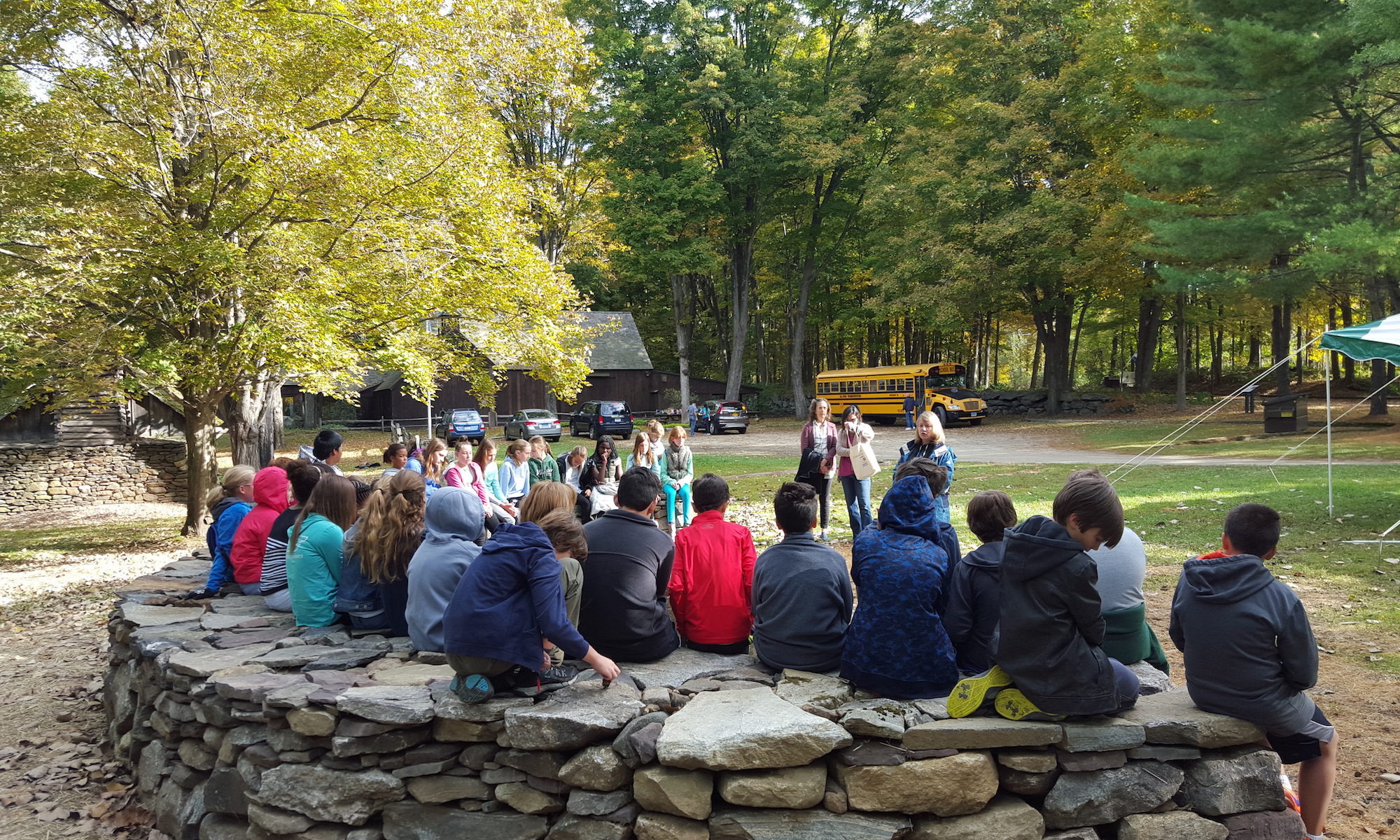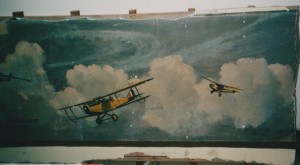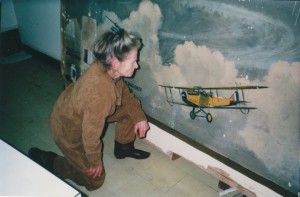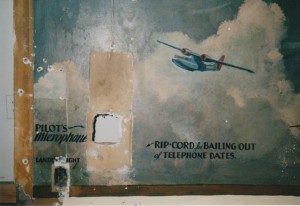The stone wall is amazing. Check out the video shot by board member Jeff Bischoff, who spearheaded the project. Everyone did an amazing job on Saturday, left with new skills and abilities, as well as some new friends and admirers. Now their work is a permanent installation at the Eric Sloane Museum.VID952015050995153748
Please help us to document Eric Sloane murals
Readers of this blog know that Eric Sloane painted a number of murals over his lifetime, perhaps his most famous being the one he executed in the lobby of the Smithsonian Air and Space Museum in Washington, D.C. I came across these photographs I took some years ago and thought I would include them here. Readers are encouraged to submit photographs and descriptions of murals known to be executed by Eric Sloane to the “Resources” section of the friends of the Eric Sloane Museum website (www.freindsof
At the time these photographs were taken, the mural pictured had been rescued by some folks at what was being developed as the Cradle of Aviation Museum on Long Island (https://www.cradleofaviation.org). I was invited by Eric Sloane’s 5th wife, Ruth Hinrichs, to view the mural which, if I remember correctly, had just been re-discovered in a storage facility. I believe that the mural was removed by some workers who were dismantling a hanger at the old Roosevelt Air Field. The workers clearly cut it out of the wall – the nominal studs are still visible under the plaster.
The mural encapsulates neatly themes that ran throughout Eric Sloane’s career. It is within this early mural that we can see Sloane’s interest in depicting the past and progress, as well as his playful sense of humor, evidenced by the treatment of the light switch and telephone at the lower left of the mural.
Corroborate and/or enhance Eric Sloane’s work
We’re not only searching for visual connections to Eric Sloane’s life work – sometimes one comes across other sources the corroborate or enhance Eric’s work in some way. If you find references to topics Eric covered in print and in oils in other outlets, please post them here. Below is an interesting reference to bells – specifically to sleigh bells and their distinctive sound:
I recall reading one of Eric Sloane’s books on early American life a passage concerning bells that were placed on harnesses, especially in winter time. The bells were used as a signal to let others know that a horse drawn vehicle was approaching. Presumably, this was done to avoid accidents. Early American lore also posits that one of the roots of the adage “I’ll be there with bells on” grew from the idea that if a driver had difficulty on a journey and required help from a fellow traveler, that driver was expected to present his harness bell strap as a “thank you” to the one who offered assistance. If, then, someone declares “I’ll be there with bells on”, he or she means to suggest that they will reach their destination quickly because the journey will be without incident.
Eric Sloane tells of sleigh bells placed on sleighs for the purpose of signaling the approach of winter travelers. I can speak from experience that driving a sleigh without bells is dangerous. Sloane (as well as my experiences) tells me that sleighs traveling across snow make little noise – noise that is further suppressed by the winer landscape, not to mention the hats and scarves worn by others out in the winter weather. Winter nights could be an especially dangerous time.
Eric Sloane also wrote the neighbors could tell one another from the sound of their sleigh bells. Bells could be purchased by the piece and in various quantities and sizes. Farmers could piece together a custom array of bells that would make a distinctive sound – a personalized horn, if you will. It is wonderful to think of an early American family, gathered around the hearth on a winter’s night, listening to the sound of “Farmer Jones” – or is that Brother Abraham? – gliding by on the family cutter.
I have been reading a fascinating book entitled The Yankee Peddlers of Early America, by J.R. Dolan (1964, Bramhall House, New York). A contemporary of Eric Sloane, Dolan must have shared very similar interests. A passage concerning the peddling of brass bells (page 151), caught my attention and reminded me of Eric Sloane’s writings on the subject of sleigh bells:
“Another item of brass that was sold almost exclusively by the peddler of the nineteenth century was the cowbell. In these days, when a farmer’s pasture is always securely enclosed with wire fencing, a bell attached to the cow is not usually necessary. But in the nineteenth century nearly every cow had to have a bell if she was to be located readily and driven in from the pasture. However the making of cowbells here never reached the point it did in Switzerland, where in certain dairy districts each family developed a cowbell with a distinctive sound that enabled the owner to distinguish his cows from those of his neighbors by the sound of the bell. The bells themselves were sometimes engraved or embossed with a distinguishing mark and since they are virtually indestructible they have become treasured family heirlooms.”
A connection, perhaps, between the early American custom of building custom sleigh bells for a distinctive sound and a similar Swiss practice of locating cows?
– Jim




